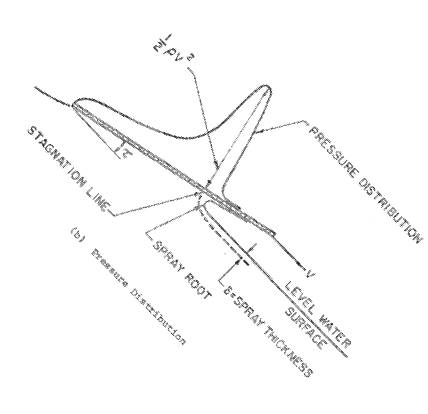Which flows make surfboards go
The illustration below is one which I posted in a prior post, It seemed to have gotten some traction.
The next illustration, is basically the same, but now I've place a surfer on the plank, and indicated both the force from interaction of the jet and plank, as well as the weight of the surfer/plank. Also, rather than having him move both out of the page and off to the right, here he has oriented his board to move just to the right. (Of course, if the jet doesn't also move of to the right, he'll just move out of the way of the jet.)
In the next illustration, I've removed the drawing of the surfer, but left the force vectors (and flow direction vector), but I've also change the jet shape. Here it's a slit or rectangluar opening, which happens to be the exact length of the projection of the angled plank.
Of course, to keep, or preserve the magnitude and direction of the force I've had to change the nature of the jet, perhaps decreasing its velocity. (Remember that the resultant force on the plank will be proportional to both the flow's speed squared, and the area impacting the plank. see earlier posts.)
Also, it's likely the surfer will have had to readjust his posture or position on the plank to accommodate the new force distribution.
But again, unless the jet slit moves with the plank, the surfer/plank will just slip off the right end.
In the next illustration, I've extended the jet slit in both directions. So now the surfer/plank can continue to move to the right. (The slit can be extended as far as you like.)
In this latest illustration, I've indicate (in dashed circles) two area of interest, the leading edge of the plank, and the trailing edge. The lines emanating from these two zones are meant to be suggestive of the edges of the jet. Their actual shape will depend on both the transverse speed of the plank as well as the speed of the flow (in the jet).
This next illustration, illustrates how they might vary for a given flow -i.e. hold the flow speed constant but change the transverse speed of the plank.
In this last illustration we have effectively two flows operating, one from the jet impacting the bottom of the plank and that from the transverse motion of the plank. It's only the jet flow that makes the “plank go” in this case. (That's not to say the transverse flow won't have consequences.)
A slight beside on design
This next illustration, is an attempt to begin to bring this all back to a what is happening on a wave-face. Perhaps you can visualize it as if the plank is now experiencing a much thicker flow, that is the jet is wider than the plank. But the plank is just on the portion of the flow closest to the viewer.
The edge of the plank (farthest from the view) is now releasing some of the flow which has impacted with the plank. The hatched area might be the bottom wetted-surface of the plank. (Those lines from the leading edges are in the plane of the jet. They just look like they are coming out of the page because of their curvature.)
At this point its tempting to start removing sections of the plank. But as you do, you might reduce the surface area in play, hence the orientation of the plank (and/or surfer) will have to adjust to maintain the same force. You might also note that the leading edge of the “jet-side” rail offers some interesting design considerations. (See “
Rails Plane”) That leading edge and the
plane-shape curve will all impact the orientation of the board (assuming that one wishes to maintain a constant force.) The same kinds of considerations are to be made for the trailing 'jet-side' rail.
And even more interesting, the flow up the face increases as you move towards the curl (see “
The Decelerating Wave-form”) hence the trail edge or tail of the plank would be experiencing a higher upward flow, which impacts tail design – you can chop more off but still achieve the same force (as the
planingforce is proportional to the flow speed squared and area.)
These are not the only considerations that determine rail design or board design, but it's a pretty important start. Perhaps you can begin to see how forward and rear rocker will impact just these simple considerations. Also, this is just for trimming situations.
---------------------------------//-----------------------------
There is one more point I'd like to make, and that's regarding the use of the term energy. Energy has magnitude only, whereas force has both magnitude and direction – and force considerations lead to design considerations.
For example, two waves may very well have the same energy, but the forces that can be tapped by the surfer/surfboard in either case will depend on how the wave is shoaling, which in turn, will determine what the magnitudes and directions of the forces that will be available – and hence design. (See “
The Decelerating Wave-form”)
In the end however, you can surf pretty much anything as long as you've got enough
planing area ... and the skill to do it.











